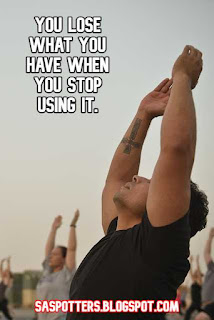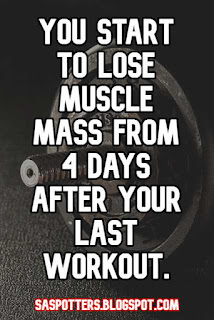 |
| Move it or lose it. |
This article is written by Rob Maxwell, M.A. Exercise Physiology, CSCS and ACSM CPT from www.fittothemax.net. Follow him on Twitter.
The 7 principles of fitness
1. Specificity2. Overload
3. Progression
4. Periodization
5. Individuality
6. Recuperation
7. Retrogression
 |
| Master all of these principles. |
Retrogression as the use it or lose it principle of fitness
There are seven principles of physical fitness. They are specificity, overload, progression, periodization, individuality, recuperation, and retrogression.
Retrogression is known as the "use it or lose it" principle of fitness.
If you stop exercising and/or being active, you will lose the benefits that the exercise has given you.
The use it or lose it principle is connected to time
Time gets blamed for many things. In health and fitness, it gets blamed a lot!
Often, I will hear a client talk about how they once had a certain physique. They talk about how as they got older; it went away.
Did it go away due to age or did they simply stop doing what they used to do? It’s the latter.
If you quit doing what you used to do, you will lose what you used to have.
There are plenty of older folks (there is no such thing as old) that are in incredible shape. Use it or lose it.
 |
| You lose what you don't use. |
Age has an overestimated role in the loss of physical fitness
Age does play a role in some decline. The key word is some.
We do start to lose some strength as we get older. We start to lose some muscle tissue as we get older. We do lose some bone density as we get older. We do lose some cardio-respiratory fitness as we get older.
Continuing to work out will drastically slow down the rate of loss. We do NOT have to lose as much as you may think.
The greatest loss comes from not doing what you used to do when you were at your peak condition.
 |
| Use it or lose it. |
Muscle does not turn into fat with age
I’ve heard the most outlandish things regarding this topic.
I have heard people say that football players get fat because the muscle turns to fat as it gets older. That is ridiculous!
Tissue can’t become another tissue. They got fat because they quit working out and kept eating like they used to.
This is a product of choice and not a product of nature. There are plenty of ex-athletes, including football players that still look and feel amazing years after retiring. Use it or lose it.
This same principle applies to everyday people - not just elite athletes.
If we take a long break from training, we will decline.
I tell my clients constantly how consistency matters. I believe that the greatest key to success in physical fitness is consistency.
Some people go 100% in the beginning of their fitness journey and either get hurt or burn out. It’s better to start out moderately and stay with it.
I often that say we need more moderation. We are a country of feast or famine! That is true in the fitness world as well.
We have people that are super fit and we have people that are morbidly obese. All countries do, but we have more of an extreme on both ends.
Doing our workouts day in and day out on a consistent basis and not overdoing it will lead to greater success for all of us! Use more moderation. Let’s not burn out and quit!
 |
| Rather be moderate and stick with it. |
You start to lose muscle from 4 days after your last workout
Here is a scary statistic. We atrophy 96 hours (about four days) after a workout has been completed.
It’s slight, but that is how quick it happens.
That means that if you work out on Monday, you are already losing some of the muscle tissue on Friday unless you stimulate that muscle again.
Plan your workout split with the 4-day atrophy rule in mind
4 days is fast!
Many people forget about this fact when they set up their workout splits.
A split routine is exercising different muscle groups on different days so that volume can increase.
A common split routine where this happens is when a trainee works out one muscle group per day.
The reason this why this split routine will lead to atrophy (muscle loss) is because you are only training one muscle group per day.
That means that it will be a week before you train it again.
When you target that muscle group again, it’s already atrophied. You've lost some of the hard-earned progress that you earned in your last workout.
 |
| Don't lose because of time. |
The best workout split to avoid muscle atrophy
It’s best to do a strength training routine where you work each muscle group 2-3 days per week.
The style doesn’t matter so much.
You can do a full body workout 2-3 days per week on non-consecutive days. If you do a split routine, make sure that each muscle group is being trained 2-3 days per week with 48 hours in-between muscle groups.
Training more often is optimal, not non-negotiable
Taking 96 hours (about four days) off from working out will not cause you to fall to pieces. Many people increase muscle mass by stimulating each muscle group once a week. More often is simply more optimal.
I’m using this science to show how quickly we lose muscle when we don't use it. As weeks turn into months and even years, the loss is substantial. It doesn’t have to happen.
Get into a manageable program and stick to it. On the positive side of the coin, we can hypertrophy (grow muscle) at any age. We all need to look after our muscles!
Cardio vascular fitness also declines when you don't use it
Cardio-respiratory fitness is measured by what is called the V O 2 max.
This is the maximum amount of oxygen that your body can use at one time. It also declines when a rest period is too long.
In fact, V O 2 max can decline all the way back to baseline (where we began) in as little as two weeks!
It is therefore so important for athletes of any sport to not get injured. If injury occurs, the athlete must take time off and then atrophy will occur.
Along these lines, it’s so important to train correctly and not push to extremes. An athlete is playing much better if they are still on the field. Fitness declines when activity stops.
 |
| Prevention keeps you on track. |
Everybody needs to exercise to prevent loss of fitness and health
This is true for non-athletes too. If we take time off from cardio, we will go backwards.
This does not mean that a trainee shouldn't rest. Of course, they should. Be smart about the rest. Rest shouldn’t be for too long.
Use what is called active rest. Active rest means resting one part of your body or system while working another. If you structure hard and easy cardio days into your week, you will be more likely to avoid taking time off.
Do a lighter day of cardio, for example, after a harder day. This will prevent injury and burnout. The key is to do things that prevent us from doing nothing at all.
 |
| Mix it up. |
Do as much as you can on days where you don't have much time
You don’t have to be overly structured when you get extremely busy and can’t make the gym, but you can do something.
Try to keep those muscles going. We experience this issue quite a bit at my gym. We have people that will take off for weeks. We tell them to try and get some exercise in. It won’t take much.
Just do something so we can prevent too much decline. Often, they will come back after a three-week hiatus and say, “I feel like I lost everything”.
So, why couldn’t they have just done something? Good question.
When we travel, we don’t have to keep moving forward. The goal is to maintain during these busy times and to not slide backwards.
It’s so important to begin with consistency.
When you start a fitness program, ask yourself what is sustainable and make that a habit.
Many people start out with a ball of fire only to flame out. It’s about starting and staying with a sustainable exercise program.
We can make so many improvements with a moderate program.
I’ve coached for many years and I’ve always said I would take an athlete that follows a consistent program versus an athlete that works his/her tail off when you see them, but you don’t see them nearly as much!
 |
| Every bit makes a difference. |
Use it or lose it. It’s a fact.
Keep going and everything will go along with you. I often hear that people gain weight as they age. This can be true. But this doesn’t happen because of the birthday.
We move less and we lose muscle (atrophy) because we quit being active. We can keep muscle on our body by staying active and working out.
When we lose muscle, our metabolism slows down. When that happens, we gain weight. This has far more to do with taking time off from moving than it does your birthday.
So many of the issues we experience as we get older (such as obesity) can be warded off by starting and maintaining a sustainable exercise program.
It takes lot more work to go back and forth. Don't make gains and then stop to lose those gains.
It’s a lot easier of a road to not stop at all.
If you have stopped, don’t lose heart. Get back on the wagon and tell yourself that you can now make progress and you are now armed with a good reason to not stop again.
 |
| Use it or lose it. Don’t stop. |
No comments:
Post a Comment